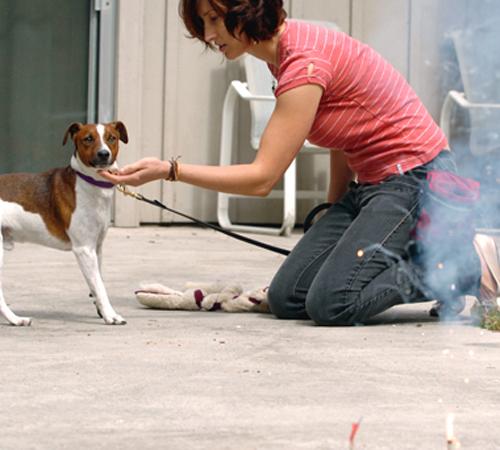Classes aim to ease pets’ fears of fireworks

The Associated Press
Jun 10, 2008
Last updated on May 13, 2016 at 11:32 a.m.
NEW YORK – Shawn O’Dierno’s rescued Doberman was a certified therapy dog who could help soothe patients and tolerated the sounds of dropped hospital equipment, loud arguments or crying visitors. But while Reid coped with the stress of a hospital room, he couldn’t handle fireworks.
“We were staying at place by a beach where the fireworks were going on,” said O’Dierno, of Portland, Ore. “He went nuts and hid behind chairs.”
The situation repeated itself at other celebrations until O’Dierno realized her dog had a fireworks phobia: “His eyes would pop open, and you could see the fear when the fireworks go off.”
Experts haven’t figured out why some pets are extremely sensitive to fireworks, but some believe the smell of gunpowder may add to jitters caused by loud explosions.
Get The Daily Illini in your inbox!
“Fireworks have many stimulus qualities that are inherently aversive to pets,” said Mary Lee Nitschke, an animal behaviorist and psychology professor at Linfield College. “The volume and suddenness of a firecracker elicits a startle reaction in most species.”
Cesar Milan, dog trainer and host of the National Geographic Channel’s “Dog Whisperer” show, says getting a dog ready for fireworks can take months.
At Behave Canine Solutions, a company that offers dog training classes in the Portland area, dogs in the Puppy Preschool program spend a day training for fireworks. The process involves integrating sound, smells and visual displays into activities such as playing or eating.
“What a dog is or isn’t exposed to, especially in the first 16 weeks, can affect their behaviors for the rest of their lives,” said Denise Mullenix, one of Behave’s trainers. The class moves puppies to different stations that play sounds of fireworks, expose them to small smoke balls and burning charcoal, and bring them near sparklers and bright flashes.
Each step, Mullenix said, is designed to “minimize stress and anxiety in situations of exposure to fireworks.”
Owners can also train their dogs at home. Milan plays recordings of fireworks at a low volume during an activity that the dog enjoys. Nitschke said she uses a toy similar to Roll Caps that produce an explosive noise and smell similar to gunpowder used in fireworks. You can also pop a paper bag, she said.
Continue introducing sounds of explosions for several weeks, increasing the volume with time. “Involve the sound into positive activities such as eating, at a low sound, or walking with your dog, so the dog becomes familiar with the sound while doing an activity that he enjoys,” Milan said.
The dog is conditioned when it stops exhibiting signs of anxiety – panting, drooling, pacing – and it’s comfortable when the recording can be played loudly, said Pam Reid, who works with the American Society for the Prevention of Cruelty to Animals to educate pet owners and professionals.
If owners don’t have months for training, veterinarian Dr. Robert Raider says other help is available. Take the pet for a checkup at least a week before the big day, and then return to the vet for sedatives if the dog is given a clean bill of health.
Raider, who works at Maspeth Animal Hospital in Queens, N.Y., recommends getting the pills a few days early to avoid a mad rush to the doctor.
Some experts – including Milan – consider sedatives an option of last resort. But those who own particularly anxious pets shouldn’t hesitate. “The kindest thing you can do is get them on medication,” Pam Reid said.
If owners find themselves unprepared on the holiday, they should forget the fireworks and concentrate on the dog, Milan said. If you’re in a park or an open area, keep the dog calm by remaining calm yourself.
“Just make sure you have very good control of your dog,” said Reid. “You want your demeanor to be calm or confident. Dogs can pick up on your demeanor, and they’ll panic if you start to panic, too.”
Reid suggests getting the dog indoors as quickly as possible. If you drove, get into your car and sit with the dog. “Get them to calm down, then mask the noise. Turn on the air conditioning or the radio,” Reid said.
If you’re indoors when the dog panics, Reid suggests giving it a hollow chew toy filled with Cheese Whiz or peanut butter. “Some dogs are OK as long as they have something to lick or chew,” she said, likening the effect to a baby’s sedation from pacifiers.
Milan also said scared pets – not animals that already have been traumatized by fireworks – can be calmed with pheromone-mimicking scents. These products release smells similar to the ones naturally produced that signal comfort or relaxation. Nitschke, who recommends DAP, or Dog Appeasing Pheromone, for canines, and Feliway for cats, said the scents helped keep her pets calm during a home remodeling.
“Medicine is great, but if you can do it without it – you can do it with good exercise,” Milan said. “Normally you walk a dog for 20 minutes but on Fourth of July, you walk an hour and a half, and you drain the energy so your dog is more tired. That is just like a sedative. But it is a more natural sedative, no side effects.”
On past Fourths, Milan said he Rollerblades with his pack of more than 20 dogs, or takes them backpacking in the mountains near his Los Angeles dog training center. He suggests doing an activity the pet will enjoy: let the dog have its day.
“Anything that can involve relaxation and fun, because that’s what you want the dog to learn,” Milan said. “Relax and have fun on the Fourth of July. That’s what people do, right? They relax and they have fun.”





